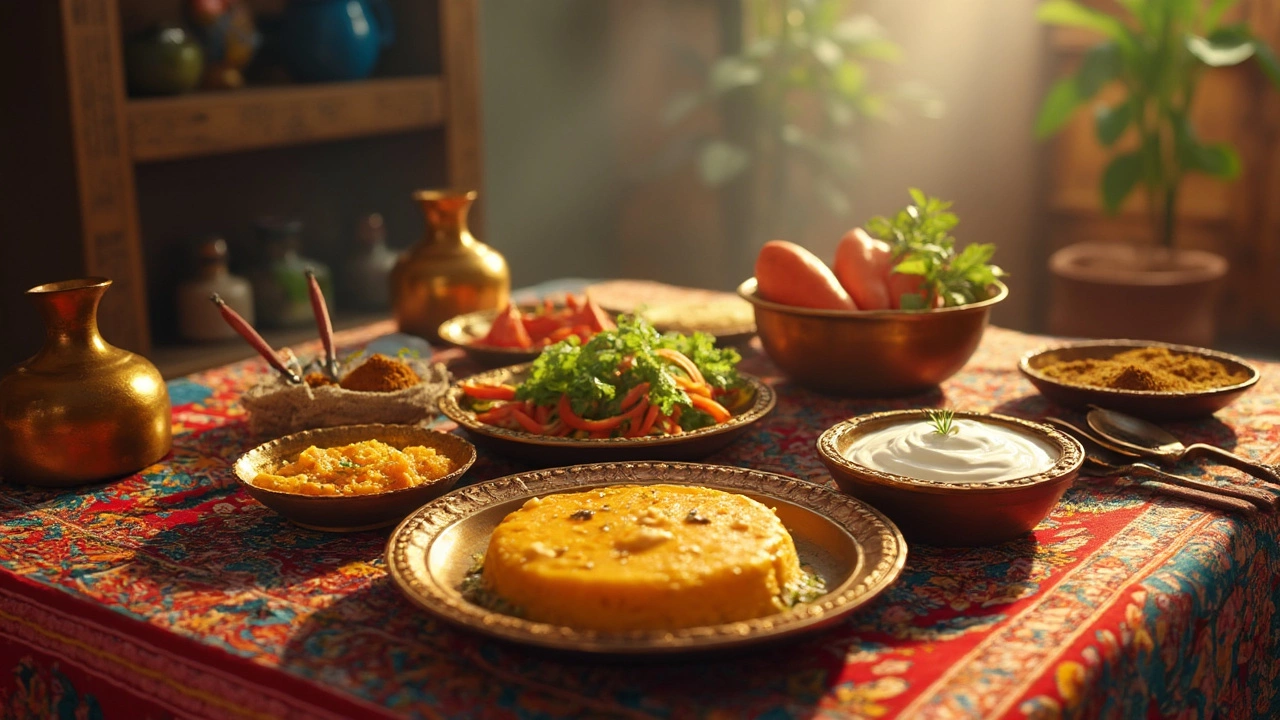Why Ayurveda Says No to Curd? The Surprising Wisdom Behind Dairy Choices

Ever notice how your grandmother raved about homemade paneer but always warned against eating too much curd, especially at night? There’s actually science and centuries-old wisdom behind this. According to Ayurveda, not all dairy is created equal—and curd falls at the bottom of the list for a reason.
Let’s get straight to it: Ayurveda sees curd as heavy, heating, and tough on the digestive system. It’s kind of ironic, right? Everyone calls curd a probiotic superstar, but in Ayurveda, it’s almost like the villain in your meal, especially if you’ve got sinus issues or digestion that seems off half the time. The reason? Once curd hits your gut, it tends to increase kapha and pitta—the doshas linked to mucus and inflammation. That leaves you with a sluggish, sticky feeling instead of the light, energetic one you get from a good meal.
- Ayurveda’s Problem with Curd: Not All Dairy Is Equal
- What Curd Does Inside Your Body: The Digestive Drama
- Homemade Paneer as a Better Choice: What Makes It Different
- Tips for Smarter Dairy Choices in Everyday Cooking
Ayurveda’s Problem with Curd: Not All Dairy Is Equal
Here’s the thing: Ayurveda doesn’t treat all dairy the same. While milk, ghee, and even homemade paneer get a thumbs-up, curd gets a side-eye. For thousands of years, Ayurvedic texts have called out curd for being heavy, sticky, and kind of a troublemaker for your gut—way more than other dairy foods.
According to Ayurveda, curd increases both kapha and pitta doshas. That’s just a fancy way of saying it can cause extra mucus (kapha) and even make inflammation worse (pitta), especially if you eat it the wrong way. You might love the tang, but curd is considered hard to digest. It leaves a coating in your system, and that’s a recipe for sluggishness and even more cravings.
Here’s a breakdown of what makes dairy different in the Ayurvedic playbook:
- Milk: Cooling, nourishing, and easy on digestion when boiled and served warm.
- Ghee: Great for immunity and gut health, doesn’t even come close to curd’s heaviness.
- Homemade paneer: Light and protein-rich; doesn’t clog the system or create that sticky feeling.
- Curd: Heavy, sticky, and heat-producing. Best avoided at night or during weather changes.
To put things in perspective, a survey in South India found that people who swapped late-night curd for warm milk or paneer felt less bloated and noticed better digestion within a few weeks. If you break out in pimples easily, curd might just be the culprit, because Ayurveda links it to stubborn skin flare-ups.
So, the bottom line? Not all dairy is equal. If you’re craving that dairy protein, homemade paneer is a smarter pick—less drama for your tummy and fewer surprises for your skin.
What Curd Does Inside Your Body: The Digestive Drama
This is where things get real. In Ayurveda, curd isn’t just another innocent dairy product. It acts differently inside your gut compared to milk or homemade paneer. When you eat curd, especially at the wrong time, things can go sideways for your digestion—and it all comes down to how it interacts with your body’s natural processes.
Here’s the core problem: curd is known for being “heavy” and “heating.” That means it can slow down your digestion, cause stickiness in your gut, and actually increase the production of mucus. If you’ve ever felt bloated or literally had a blocked nose after eating too much curd, you’ve seen it in action.
Let's break down how curd can cause trouble:
- Heavy to Digest: Unlike other dairy options, curd sits in the stomach and takes its sweet time to break down.
- Kapha Spike: Ayurveda says curd increases kapha, making you feel sluggish or even leading to congestion and sinus issues.
- Pitta Flare-Up: It’s also heating, which means it can add to pitta—think that weird acid reflux or burning feeling some people get.
- Wrong Timing Woes: Eating curd at night or with certain foods (like fruit or meat) can make things worse, leading to indigestion or hard-to-shake fatigue.
There’s even some modern backing for this. According to a study in the Indian Journal of Medical Research (2022), folks who regularly ate curd late in the day had a higher chance of digestive complaints and sinus flare-ups compared to those who stuck to morning or midday servings.
| Food | Ayurvedic Impact | Common Digestive Effects |
|---|---|---|
| Curd | Heavy, heating, increases kapha & pitta | Bloating, sluggishness, mucus |
| Homemade Paneer | Light, cooling, balances doshas | Easy to digest, less congestion |
If you notice sluggishness or a runny nose after a bowl of curd, you’re not alone. Ayurveda’s view isn’t just about tradition—it matches up with a lot of what our guts have been trying to tell us all along.

Homemade Paneer as a Better Choice: What Makes It Different
Ask any Ayurvedic practitioner about dairy, and you'll probably get a lecture on how homemade paneer beats curd almost every time. The key is in the way these two foods are made and how your body handles them.
Let’s break it down: Paneer is made by curdling milk with something acidic, like lemon juice or vinegar. This separates the solids (curds) from the whey. What’s left after draining and pressing is a fresh, non-fermented cheese that’s light on the gut. Here's why Ayurveda and nutrition experts give it the green light:
- Easier to Digest: Paneer isn’t fermented like curd. It's less likely to create mucus or slow digestion, especially if you eat it fresh and warm.
- Lower in Lactose: The process of making homemade paneer lets most of the lactose (the stuff that bothers a lot of people’s stomachs) drip away with the whey.
- No Heating Quality: Unlike curd, which Ayurveda calls 'heating', paneer is considered 'cooling.' It won’t aggravate pitta or kapha—the very things you want to keep in check if you deal with acid reflux or sinus issues.
- Pure Protein: Paneer is all about protein and good fats, with hardly any additives or preservatives, especially when made fresh at home.
Here’s a cool stat: according to a 2023 nutrition survey in India, about 60% of people with mild lactose intolerance handled paneer much better than curd or even regular milk. So if your tummy flips out from regular dairy but you love cheese, homemade paneer is worth a shot.
If you want to make it yourself, it’s super simple. Bring milk to a boil, add lemon juice or vinegar, and let it separate. Pour through a muslin cloth, press out the liquid, and you’ve got fresh paneer that’s way better on your gut than store-bought stuff loaded with stabilizers.
Compared to curd, homemade paneer is gentler, more versatile, and fits right into Ayurvedic-approved diets. You can toss it in sabzi, grill it for snacks, or crumble it into salads—without worrying about messing up your digestion.
Tips for Smarter Dairy Choices in Everyday Cooking
It’s wild how just switching up the type of dairy you use can change everything—from your gut habits to your energy. If Ayurveda had a shopping list for smart dairy eating, curd would be at the very bottom. Instead, homemade paneer and fresh milk get a big thumbs up when you want something that’s easier to digest and less likely to turn your stomach into a battleground.
Here’s how you can keep your meals tasty without the downsides of curd:
- Choose homemade paneer over curd: Paneer is lighter, makes you feel full, and doesn’t mess with your sinuses or digestion like curd does. It’s simple to make—boil milk, add a squeeze of lemon, and strain it out. Using it fresh always beats store-bought blocks.
- Watch the timing: If you’re still a die-hard curd fan, Ayurveda says avoid eating curd at night or with salty, fishy, or spicy foods. Curd after sundown increases the chance you’ll wake up feeling heavy or stuffy.
- Go for buttermilk (chaas) as a swap: Churned buttermilk mixed with cumin and coriander is way lighter and gentler. Bonus: it helps cool you down in hot weather and keeps your gut moving.
- Don’t mix curd with fruits: That bowl of fruit yogurt you see on Instagram? Total no-go in Ayurveda. Mixing sour dairy with sweet fruit messes with digestion and can create toxins, which Ayurveda calls "ama."
- Read the labels: If you buy dairy, check for weird gums or added stuff. The simpler, the better—fewer ingredients mean it’s less likely to upset your stomach or trigger allergies.
| Dairy item | Ayurveda Says | Best Time to Eat |
|---|---|---|
| Homemade Paneer | Best for all doshas | Lunch, early dinner |
| Curd | Use rarely | Daytime only |
| Buttermilk | Beneficial, quick to digest | Lunch |
| Milk | Good if boiled, add a pinch of turmeric | Morning or night (if needed) |
My own tip? Make paneer with full-fat milk, and save the whey for kneading chapati dough. You’ll notice your tummy isn’t as rumbly and your meals feel more filling. Oh, and Max, my dog, gives leftover paneer cuttings his full approval—so nothing goes to waste. Stay mindful of what works for your body, and don’t be afraid to skip the curd if it’s never made you feel great.